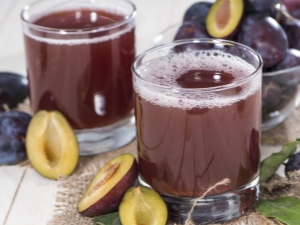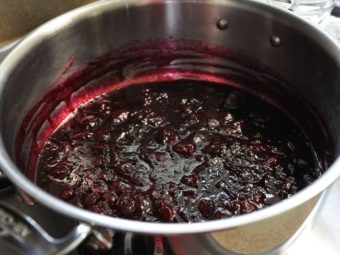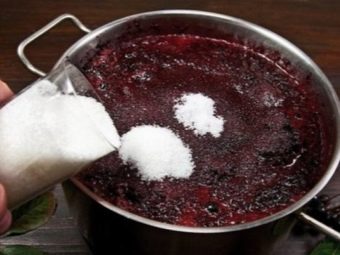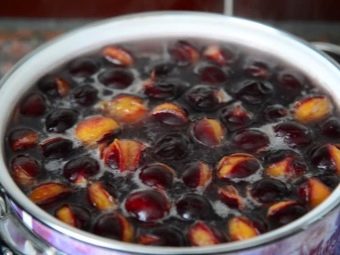Plum Juice: Product Properties and Recipes

Plum juice is a storehouse of vitamins and a pleasant sour taste. Choosing between homemade and purchased options, you should choose the first.The juice made from the plum itself is much more useful, especially since it is not difficult to make it.
Features and benefits
Plum juice, in comparison with other fruit and berry juices, is less popular, which is absolutely unfair.
Natural juice from plums has a lot of useful properties. It contains a large amount of vitamins of group B, necessary for the formation of muscle tissue and beneficial effects on the nervous system. Vitamins A, E and ascorbic acid, also contained in the juice, provide a tonic and immuno-strengthening effect. It is noteworthy that in the process of heat treatment, they are destroyed slightly.
Unique vitamin P, also available in plum juice, is retained during heat treatment. In the body, it is responsible for the elasticity of blood vessels, the elimination of "negative" cholesterol.
According to the potassium content, plum overtakes apples and pears. And potassium, in turn, strengthens the heart muscle. In addition, it normalizes blood pressure and contributes to the removal of excess fluid from the body.
Vitamin PP, part of the juice, is useful for people with joint diseases. A drink is also indicated for anemia.
Plum juice is one of the effective means of cleansing the body of toxins. Due to the content of pectins, fiber and volatile production, the drink has a mild laxative and diuretic effect, improves intestinal motility, which facilitates digestion, and also provides an antibacterial effect.
Juice is quite easy to make at home, even without having certain culinary skills. In finished form, it can be drunk or added to pastries, moisten cakes for cakes. On the basis of plum juice it is possible to prepare low alcohol drinks, as well as cocktails and jellies, mousses.
Sweet and sour juice can be an excellent marinade for meat or hot sauce.
Per 100 g of product there are 68 calories, the basis of which is carbohydrates. This is due to the high content of sugars, however, they are natural. Due to this, the juice is easily digested, while, as already mentioned, improving the work of the intestine.
Easy digestibility, a large amount of vitamins and microelements, as well as the naturalness of the juice allows it to be used for children's menu. At the same time, the juice prepared by own hands is in many ways superior to the acquired analog.
Contraindications
The benefits and harms of juice are due to its composition. Despite the beneficial effects of juice on the digestive tract organs, during the period of exacerbation of diseases of these organs, its consumption should be abandoned. This is also true in the acute phase of urinary tract diseases. A sour drink will irritate already inflamed tissues.
You should not drink juice with individual intolerance and allergies to its components. Because of the high glucose level, people with diabetes will also have to give it up.
Very carefully due to the content of sugars should be drunk to people prone to rapid weight gain, pregnant women and women with breastfeeding.
Like any drink, plum juice is only useful with moderate consumption. Excessive drinking can cause abdominal pain, inflammation of the oral mucosa, nausea, vomiting. The optimal dosage is 100 ml of juice, this amount can be drunk 3 times a day.
How to cook?
For juice, you must take ripe plums, better late-ripening. They must be whole, without rot.
Regardless of the characteristics of the recipe, the primary preparation of the fruit involves their inspection and washing. In the presence of rot, it should be cut off or not to use such a plum, since even a small part of it can ruin the taste of several liters of juice, giving it a moist, earthy smell. Wash the fruit should be in cool water, removing debris, leaves and stalk.
Juice with pulp from plums
Ingredients:
- 6 kg of plums (for example, varieties "Hungarian");
- 0.8-1 kg of granulated sugar.
After pretreatment, the fruit is incised, and the bones are removed from it. The resulting raw material is placed in a bowl and filled with water so that it is 2-2.5 cm above the drain. Put the container on low heat and boil until the flesh begins to separate from the skin.
The resulting composition should be slightly cooled, and then grind through a colander. For this, the latter is installed above a large saucepan. A small amount of raw material is poured into a colander and ground with the help of a pulverizer. Only pelts that are thrown away should remain in the colander.
The resulting plum puree is poured with water in which it is boiled, sugar is added.
It is better to take small and add it gradually, carefully mixing and periodically tasting. Sugar may need a little more or less than the specified amount.
After that, the juice should be boiled over low heat, boiled for 5-7 minutes and poured into pre-sterilized jars, rolled up with lids. Banks to put on the cover and insulate. After cooling, the banks turn over and put away for storage in a cool place.
The drink is quite thick and concentrated. Usually, when used, it is diluted slightly with boiled water to the desired degree of thickness and acid level.
Apple and Plum Juice
For this drink you need:
- 1.5 kg of white plums;
- 1.5 kg of apples;
- 450 grams of sugar.
Plums need to sort, wash, remove bones. Apples also wash, cut into halves, remove the hearts, and then cut into slices.
The prepared raw material is folded into a saucepan and filled with water so that it only covers the apple-plum mass. On a low heat, the latter is boiled until the skin begins to separate from the pulp.
Water in which apples and plums were prepared should be drained into a separate container, and fruit and berry mush in a colander. It should drain a little, after which it is frayed through a colander. The puree obtained in the course of these manipulations is poured with water, which has previously been drained into a separate container, sugar is added and, thoroughly mixed, boiled for another 10-12 minutes.
Hot juice is poured into sterilized jars and rolled with lids.
Prune juice through juicer
The presence of a juicer greatly simplifies the process of making juice. For this take:
- 4 kg of plums;
- 2 liters of water;
- 300-350 grams of sugar.
Washed and cut into halves of pitted plums are placed in a juicer. The juice and pulp are collected in a special liquid, and the cake is in another. If the latter also contains a lot of pulp, it is re-passed through the unit.
The resulting mixture is laid out in a saucepan, water is added, the sugar is gradually introduced and mixed well. The composition is put on a slow fire and brought to a boil, after which another 25 minutes is boiled. At this time, the juice must be stirred and the foam that appears will be removed.
After that, the juice should be slightly cooled and poured into the banks that have undergone preliminary sterilization. Cover with lids, and after cooling the cans should be removed in a cool place for further storage for the winter.
Fresh plum
The maximum benefit can be obtained from freshly squeezed plum juice, without subjecting it to heat treatment. Pamper yourself and loved ones with such a drink will be possible only during the collection of fruits.
The recipe is extremely simple - bones are removed from the washed plums, and the resulting halves are passed through a juicer. This juice is very concentrated, it must be diluted with boiled water, sugar is added to taste.
But even after dilution with water, such fresh juice is a real test for the pancreas, so fresh juice should be drunk no more than 2 times a week. For an adult, a single dosage is 200 ml, for a child - 100 ml.
Tips experienced housewives
When boiling the berries with water for the first time, they should be periodically mixed, and the foam should not be removed with a slotted spoon, but mixed inside the composition. During the subsequent boiling, the juice will have to be mixed, practically without moving away from the stove, and the foam that appears will be removed with a slotted spoon.
The amount of sugar is about 100 g per 1 liter of juice.
However, this figure depends on the variety of plums and personal preferences. In this regard, it is recommended to introduce sugar gradually, in small portions and adjust its quantity to taste. Sugar is better to take fine, it dissolves faster.
In addition to apples, pears, peaches, aronia, grapes and cherries are well felt in plum juice. They also undergo preliminary training and are boiled together with plums. A further recipe is no different from the standard one. Some hostesses in the last minutes of boiling juice add freshly squeezed orange, cherry, apple juice.
It should be remembered that the acidity of the drink increases, and usually it is required to add a small amount of sugar to the juice.
See how to make plum juice in the video below.













































